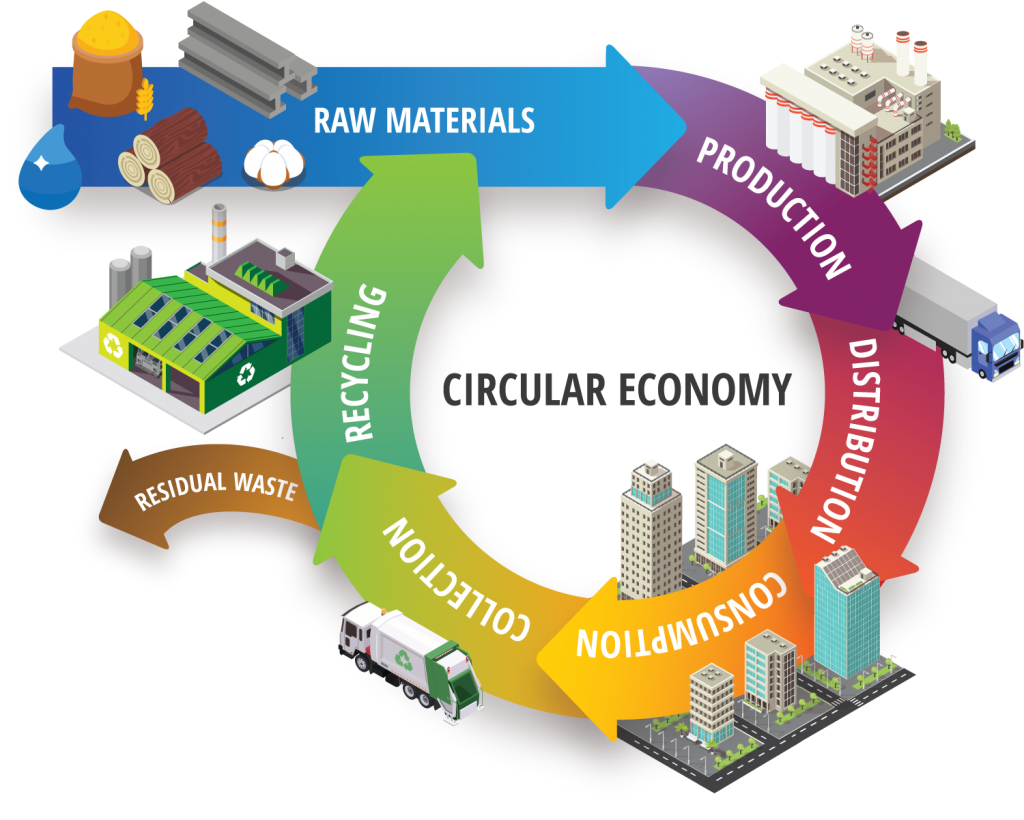It is now widely known that greenhouse gas emissions produced by human activities have influenced weather and climate conditions across the globe. This is observed in extreme conditions such as heat waves, heavy rains, droughts and tropical cyclones.
As the COP26 Climate Change Conference takes place in Scotland this year from October 31 to November 12, the world’s attention is drawn on an issue that affects the globe as a whole.
A Linear Economy contributing to climate change
Since the industrial revolution, the use of materials has kept increasing at an accelerated rate. It has more than tripled since 1970 leading to currently 100 billion tonnes of materials entering the global economy every year. According to the UN International Resource Panel, this could once more double by 2050 if nothing is done.
The way in which humans have been extracting, transforming, manufacturing, using and discarding resources has been to a great extent, the same: a linear approach of Take-Make-Waste.

Greenhouse gases released while extracting, processing and manufacturing goods, amount to 62% according to a report (Link to: https://www.circularity-gap.world/2021) by Circle Economy (Link to: https://www.circle-economy.com/), a group supported by UN Environment and the Global Environment Facility. The rest of the 38 % are emitted during transport and use of products and services
The Circular Economy as a means to fight climate change
In tackling climate change and to meet the goals of the Paris Agreement on Climate Action, governments worldwide have focused on renewable energy, energy efficiency and avoiding deforestation.
The findings of the Circle Economy study suggest that a combination of climate mitigation action and a circular economy enacted globally can prevent the worst effects of climate breakdown. Currently, our economy is 8.6% circular. This means that just 8.6% of 100 billion tons of mineral, metals, biomass and fossil fuels that enter the economy are re-used every year. The rest, leave us with what is termed as the “Circularity Gap”.
The report finds that just by doubling our current circularity percentage, we can achieve the goals to fight climate change. At the same time however, we are warned that the circularity trend is decreasing. In 2018 it was 9.1%. It is therefore crucial that efforts are placed on transforming the current outdated ‘take-make-waste’ model to a circular one.
The road to a Circular Economy
Achieving a truly circular economy is a broad issue that requires participation by many actors from consumers to industry trough to policy makers and governments.
Dependence on new raw materials and generation of waste need to be reduced. Consumers can contribute through conscious sorting of waste so that materials recovered are received in an as clean and pure form as possible to reduce processing, all while demanding change.

Re-engineering of supply chains all the way to mining of resources and production of materials so that fewer raw materials are used is also a key factor. Designing such processes with the reduction of emissions in mind would help make economies more efficient.
Innovation that focuses on satisfying society’s material needs by doing more with less through intelligent resource management would further contribute to achieving a truly circular economy.
In line with the above, the Circular Based Waste Management (Link to: http://circular-waste.eu/) project, funded by Iceland, Liechtenstein and Norway through the EEA and Norway Grants Fund for Regional Cooperation, aims to play a role in implementing circular economy practices in three municipalities in Lithuania, Estonia and Ukraine.
The approach taken is a collaborative one, through knowledge and best practice exchange among the project partners with a long term vision aligned with reaching EU targets on waste management.


